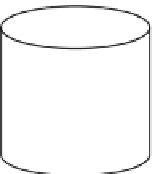Environmental Engineering Reference
In-Depth Information
■
Example 11.9
Problem:
What is the area of the circle shown in Figure 11.7?
Solution:
Area of circle = π ×
r
2
= π × 6
2
= 3.14 × 36 = 113 ft
2
a
rea
of
a
C
irCular
or
C
ylindriCal
t
anK
If we were assigned to paint a water storage tank, we must know the surface area of
the walls of the tank so we can determine how much paint is required for the job.
To compute the surface area of the tank, we should first visualize the cylindrical
walls as being a rectangle wrapped around a circular base. The area of a rectangle
is found by multiplying the length by the width; in this case, the width of the
rectangle is the height of the wall, and the length of the rectangle is the distance
around the circle—that is, the circumference. Thus, the area of the side walls of
the circular tank is found by multiplying the circumference of the base (
C
= π ×
D
)
times the height of the wall (
H
):
Area = π ×
D
×
H
(11.6)
■
Example 11.10
Problem:
A cylindrical tank is to be painted. The top surface area of the tank is
314 ft
2
. The diameter is 20 ft and the height is 25 ft. How much paint is needed to
cover the tank? (See Figure 11.8.)
Solution:
Area = π × 20 ft × 25 ft = 3.14 × 20 ft × 25 ft = 1570.8 ft
2
To determine the amount of paint needed, remember to add the surface area of
the top of the tank, which is 314 ft
2
. Thus, there must be sufficient paint to cover
1570.8 ft
2
+ 314 ft
2
= 1884.8 or 1885 ft
2
. If the tank floor should be painted, add
another 314 ft
2
.
20
ft
25
ft
FIGURE 11.8
Illustration of cylindrical tank for Example 11.10.





Search WWH ::

Custom Search